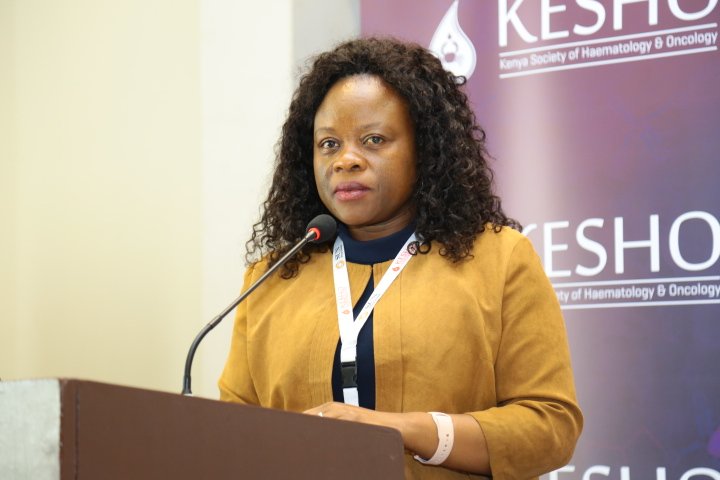Raising Awareness for Sarcoma and Bone Cancer in Children

By Dr. Catherine Nyongesa
July is Sarcoma and Bone Cancer Awareness Month, a time dedicated to shedding light on these often-overlooked cancers. Sarcomas are malignant tumors that arise in soft tissues like muscle, fat, and nerves, while bone cancers develop within the bones. This month is crucial for raising awareness about these rare and challenging forms of cancer in children, who predominantly bear the brunt of these diseases.
Sarcoma and bone cancer can have a devastating impact on the lives of young patients and their families, causing physical and emotional challenges that extend far beyond the diagnosis itself. Unlike many other types of cancer, which are more commonly seen in adults, sarcoma and bone cancer predominantly affect the pediatric population. These malignancies arise in the connective tissues, including bones, muscles, nerves, and blood vessels, posing significant hurdles in diagnosis and treatment. The rarity and complexity of these cancers require specialized care, multidisciplinary approaches, and a deep understanding of the specific challenges faced by young patients.
Here are five essential things to know about these rare childhood cancers and ways you can help support the children and families affected:
Survival Rates Vary
Survival rates for sarcoma and bone cancer depend on various factors, including the type and stage of cancer. According to the American Cancer Society, the five-year survival rate for soft tissue sarcomas is 65.8 percent, while it is slightly higher at 68.9 percent for bone and joint sarcomas. These rates drop significantly based on how far the cancer has spread at the time of diagnosis. Early detection and timely treatment play a crucial role in improving survival rates.
Challenges in Distinguishing Childhood Bone Cancer and Sarcoma
Sarcomas, especially those found within organs, can be challenging to distinguish from other types of cancer. As a result, the incidence of sarcomas is likely underestimated. The National Cancer Institute acknowledges the difficulty in accurately determining the prevalence of sarcomas due to their resemblance to other cancers within organs. Diagnosing bone cancer in children can also be complex due to several factors, such as rarity, overlapping symptoms with other conditions, and the need for additional tests like biopsies for confirmation.
Risk of Secondary Cancers
Standard treatments for childhood bone cancer and sarcoma, including surgery, chemotherapy, and radiation therapy, can have lasting effects. These treatments can cause complications such as pain, limited mobility, fatigue, and increased risk of infections. Survivors also face the risk of developing secondary cancers later in life, such as stomach cancer, thyroid cancer, melanoma, and acute myeloid leukemia. Regular follow-up visits and screenings are essential to detect any potential secondary cancers early.
Connection to Inherited Disorders
Both bone cancer and sarcoma in children can be associated with certain inherited disorders. For instance, children with Li-Fraumeni syndrome, a genetic condition caused by mutations in the TP53 gene, have an increased risk of developing osteosarcoma. Additionally, children with hereditary retinoblastoma, a genetic eye cancer, may be prone to developing bone tumors, including osteosarcoma. Inherited disorders such as neurofibromatosis type 1 (NF1) can increase the risk of developing soft tissue sarcomas. Genetic counseling and regular check-ups are recommended for individuals with these inherited disorders.
Raising Awareness
Raising awareness about childhood sarcoma and bone cancer is essential to promote early detection, research advancements, and support for affected families. Here are some ways to contribute:
- Educate: Learn about pediatric sarcoma and bone cancer signs, symptoms, and risk factors. Share this knowledge to promote early recognition and intervention.
- Get involved: Participate in events like walks, seminars, or social media campaigns, and wear a sarcoma awareness ribbon to show your support.
- Advocate: Write to local representatives and policymakers, urging increased funding for research to improve treatment options, outcomes, and quality of life.
- Donate: Contribute to pediatric cancer organizations that invest in research and provide vital resources to families.
Organizations like Solving Kids’ Cancer are dedicated to investing in groundbreaking studies and clinical trials, aiming to unlock new treatment options and improve survival rates for children with rare childhood cancers like sarcoma and bone cancer. Some of the latest research in this field explores revolutionary approaches, including harnessing the power of the immune system through immunotherapy.
When you give to Solving Kids’ Cancer, you help fuel life-saving research initiatives, providing better outcomes and transforming the lives of children battling these challenging diseases—because every kid deserves to grow up.




